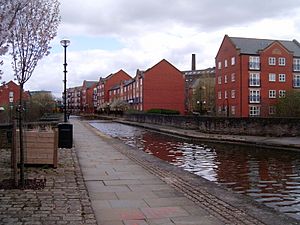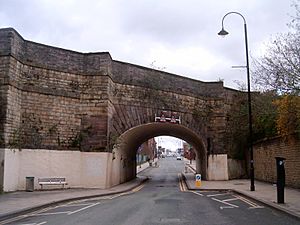Store Street Aqueduct facts for kids
Quick facts for kids Store Street Aqueduct |
|
|---|---|

Store Street Aqueduct at the canal level
|
|
| Coordinates | 53°28′47″N 2°13′39″W / 53.4796°N 2.2274°W |
| OS grid reference | |
| Carries | Ashton Canal |
| Locale | Manchester |
| Maintained by | Canal & River Trust |
| Heritage status | Grade II |
| Characteristics | |
| Trough construction | Masonry |
| Pier construction | Masonry |
| Total length | 220 feet (67.1 m) |
| Width | 17 feet (5.2 m) |
| Traversable? | Yes |
| Towpaths | N Side |
| Number of spans | One |
| History | |
| Designer | Benjamin Outram |
| Opened | 1798 |
The Store Street Aqueduct is a special bridge in Manchester, England. It carries the Ashton Canal over Store Street. This amazing structure was built in 1798 by Benjamin Outram.
It is a very important historical building, known as a Grade II* listed building. The aqueduct is built at a 45-degree angle, which is called a skew arch. It is thought to be the first major bridge of its kind in Great Britain. It is also the oldest skew aqueduct still being used today.
What is an Aqueduct?
An aqueduct is like a bridge that carries water. The Store Street Aqueduct was built to carry the Ashton Canal over a small stream called Shooters Brook. The canal water flows on top of the bridge.
The aqueduct is made of strong stone. It has large, wedge-shaped stones called voussoirs that form the arch. Its walls are built with carefully placed stones. It also has triangular supports called buttresses to make it even stronger.
Around 1805, Shooters Brook was put into an underground pipe. Store Street was then built over the pipe. The canal on top of the aqueduct is about 4.6 meters (15 feet) wide. It is also about 1.45 meters (4.8 feet) deep.
The arch of the aqueduct is about 7.6 meters (25 feet) wide if measured straight across. But because it's on a skew, its diagonal length is about 10.5 meters (34.4 feet). The arch rises about 2.75 meters (9 feet) above the road below.
The Clever Skew Arch Design
When canals or railways needed to cross a road, engineers usually tried to make them cross at a right angle (90 degrees). This was the easiest way to build a strong bridge. Building stone bridges at a sharp angle, like more than 15 degrees, was very difficult. These angled bridges often ended up being weak.
Before the Store Street Aqueduct, engineers built arches with the stones laid parallel to the bridge's ends. This meant the weight of the bridge pushed straight down to the foundations. If they tried to build a bridge at an angle, this method would make the forces push outside the supports. This made the bridge unstable.
Benjamin Outram found a new way to build these angled bridges. His design for the Store Street Aqueduct was very clever. It allowed the bridge to be strong even at a 45-degree angle. This was a big step forward in bridge building.
A Lasting Legacy
The Store Street Aqueduct is still standing and is very strong. However, over many years, water started to leak through the stone joints. Because of this, the special way the stones were laid in a spiral pattern can no longer be seen. The inside surface of the arch was covered to fix the leaks.
Later, railway engineers improved on Outram's ideas. They developed a method called helicoidal construction. This became the standard way to build angled bridges in England. The Store Street Aqueduct was an important early example of this type of engineering.


